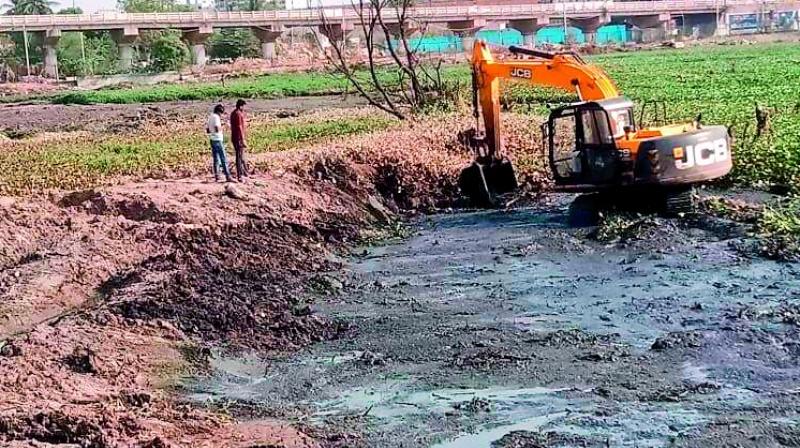Lake revamp affects downstream bodies
Contaminated water released without treatment.

Hyderabad: The Greater Hyderabad Municipal Corporation has been releasing highly contaminated water from the city’s lakes into downstream water bodies leading to the Musi river.
On the instructions of state government, the GHMC has embarked on a programme to improve the lakes and strengthen bunds in 20 lakes during the first phase at an estimated `279.78-crore project.
Violating Irrigation Act norms, the corporation has been demolishing surplus weirs and bunds in the name of dewatering the lakes without first treating the water. Corporation officials claim that this is the only possible way to protect the city lakes, even at the risk of contaminating downstream water bodies.
Diverting contamination from one place to another is a human rights violation, according to the law.
Following High Court orders, the state government had instructed the civic body to take up lake development and beautification programmes, which involves bund improvement, bund strengthening and landscaping. The corporation has shortlisted 20 lakes to develop.
Corporation officials, instead of strengthening the bunds, are demolishing them and the surplus weirs. They have already begun the dewatering of Nalla Cheruvu in Uppal, demolished surplus weirs in Hasmathpet lake and Patel Cheruvu and demolished the bund of Mukkidi Cheruvu in RK Puram.
GHMC chief engineer (lakes) Kanna Suresh Kumar said that in order to save the lakes, the corporation had no other way but to demolish the structures to divert the highly contaminated water which is stagnant for several years. He said that the corporation would demolish the bunds and divert the contaminated water downstream to remove sludge and silt.
Mr Kumar said that this procedure would minimise contamination in city lakes and protect at least a few from extinction. The chief engineer said that after dewatering 20 lakes, sewerage water would be cleaned at the end point before letting it into the Musi river.
Terming the dewatering and diversion of contaminated water from one lake to another as a violation of human rights and the Irrigation Act, Mr B.V. Subba Rao, an environmental specialist, said that engineers working on the lake development programme had no objective and did not know about the status of water contamination in the water bodies.
“How can the engineers deputed from the irrigation department know about the ground reality of water contamination and hazards of diverting it to downstream villages? The state government should depute environmental engineers who understand the problems before providing a solution,” he said.
Mr Subba Rao said that downstream water bodies would be polluted further and this would not only lead to ground water contamination, but also emanate stench and lead to air pollution affecting thousands of people living in downstream areas of the rivers.
Contradicting Mr Mr Subba Rao’s views, Mr Kumar said that residents should not let sewerage water into water bodies and the Hyderabad Metropoli-tan Water Supply and Sewerage Board has to construct a proper network to avoid diversion into downstream water sources.
The issue has been taken to the notice of Dr Rajiv Sharma, chief adviser to the government, as well as the chairman of the Telan-gana State Pollution Control Board.
Encroachers grab land as water levels decrease
The lake improvement programme by the Greater Hyderabad Municipal Corporation is already showing its ill effects. The civic body has begun dewatering the Nalla Cheruvu in Uppal and encroachers who hold pattas in water bodies have been approaching corporation to construct bunds away from their lands. The corporation has already embarked on a similar programme on other lakes and this will encourage encroachers to make the lakes extinct.
According to highly placed sources, the delay in fixing boundaries of water bodies by the revenue department has given scope to land grabbers to encroach on water bodies. Ever since the dewatering of Nalla Cheruvu began, a few persons have already obtained pattas from the revenue department and asked the civic body to construct bunds away from their lands. Of about 180 lakes in the city, the revenue department has fixed boundaries for only 140. Sources said that this has disabled the corporation to construct bunds and fence the lakes and is giving scope to encroachers to grab lands and construct unauthorised structures. They said that the dewatering programme will aid the extinction of lakes.
A senior GHMC official said that a few persons have already approached the civic body with pattas in the full tank level of Nalla Cheruvu. He said that this was due to delay of boundary fixation by the revenue department. He said that further delay will create more problems and The corporation will have to fight court cases protecting the lands. The official said that the corporation is already facing pressure from local politicians to change the FTL levels of lakes.

